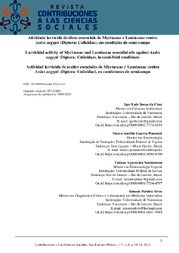Atividade larvicida de óleos essenciais de Myrtaceae e Lamiaceae contra Aedes aegypti (Diptera: Culicidae), em condições de semi-campo.
Atividade larvicida de óleos essenciais de Myrtaceae e Lamiaceae contra Aedes aegypti (Diptera: Culicidae), em condições de semi-campo.
Author(s): CRUZ, I. L. S. da; PIMENTEL, M. A. G.; NASCIMENTO, T. A.; ALVES, S. P.; MALECK, M.; QUEIROZ, M. M. de C.
Summary: RESUMO- A crescente resistência de Aedes aegypti a métodos convencionais de controle de vetores tem impulsionado a busca por alternativas sustentáveis, como o uso de óleos essenciais. Este estudo investigou a eficácia residual dos óleos essenciais de Eugenia caryophyllus, Eucalyptus citriodora, Eucalyptus staigeriana e Mentha arvensis sobre larvas de Aedes aegypti em condições de semi-campo, durante 72 horas. A metodologia envolveu a aplicação dos óleos em larvas de terceiro e quarto estádio, com avaliações de mortalidade aos 24, 48 e 72 horas. Os resultados mostraram que o óleo de Eugenia caryophyllus foi o mais eficaz e persistente, mantendo alta taxa de mortalidade ao longo do tempo. Em contraste, os óleos de Eucalyptus citriodora, Eucalyptus staigeriana e Mentha arvensis apresentaram eficácia decrescente. Estes achados indicam que, embora os óleos essenciais tenham potencial como biopesticidas, a volatilidade e a exposição ambiental podem reduzir sua eficácia, sugerindo a necessidade de estratégias de reaplicação ou tecnologias de liberação lenta. A pesquisa destaca a relevância de considerar fatores ambientais na formulação e aplicação desses produtos como alternativas sustentáveis no controle de Aedes aegypti. ABSTRACT- The increasing resistance of Aedes aegypti to conventional vector control methods has driven the search for sustainable alternatives, such as essential oils. This study investigated the residual efficacy of essential oils from Eugenia caryophyllus, Eucalyptus citriodora, Eucalyptus staigeriana, and Mentha arvensis on Aedes aegypti larvae under semi-field conditions over 72 hours. The methodology involved applying the oils to third and fourth instar larvae, with mortality assessments at 24, 48, and 72 hours. The results showed that Eugenia caryophyllus oil was the most effective and persistent, maintaining a high mortality rate over time. In contrast, the oils from Eucalyptus citriodora, Eucalyptus staigeriana, and Mentha arvensis exhibited decreasing efficacy. These findings indicate that, although essential oils have potential as biopesticides, volatility and environmental exposure may reduce their effectiveness, suggesting the need for reapplication strategies or slow-release technologies. The research highlights the importance of considering environmental factors in the formulation and application of these products as sustainable alternatives for controlling Aedes aegypti.
Publication year: 2024
Types of publication: Journal article
Unit: Embrapa Maize & Sorghum
Observation
Some of Embrapa's publications are published as ePub files. To read them, use or download one of the following free software options to your computer or mobile device. Android: Google Play Books; IOS: iBooks; Windows and Linux: Calibre.
Access other publications
Access the Agricultural Research Database (BDPA) to consult Embrapa's full library collection and records.
Visit Embrapa Bookstore to purchase books and other publications sold by Embrapa.

